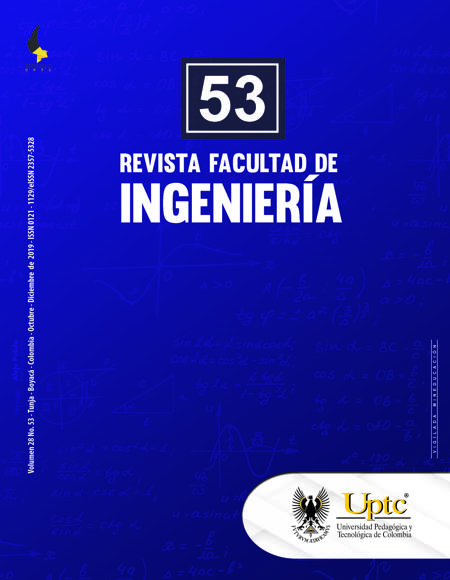Numerical and Comparative Study of the Turbulence Effect on Elbows and Bends for Sanitary Water Distribution

Abstract
This article presents the numerical and comparative study of the effect of turbulence on elbows and bends for the parameters of an inch, by means of CFD and under the same working conditions (velocity, pressure and temperature), to determine the fluctuation in turbulence of kinetic energy between these two accessories varying the turbulence models. Two methodologies were used for this investigation, kappa-epsilon (k-ε) and kappa-omega (k-ω). The method (k- ε) is divided into three models: standard, RNG and realizable, in which turbulence of kinetic energy and of dissipation is transformed. The method (k-ω) also has three variants: standard, SST, BSL. The work presents a greater turbulence for the method of (k- ε) in kinetic energy and dissipation under the standard model for both elbow and bend, while in the method (k-ω) there is a greater turbulence of kinetic energy in the BSL model for both accessories, as in the method (k-ε) the standard model of (k-ω) represents a greater frequency turbulence.
Keywords
bend, elbow, kappa-epsilon, kappa-omega, turbulence
References
[1] J. Jiménez, "Turbulence structure and vortex dynamics," Eur. J. Mech. - B/Fluids., vol. 20 (5), pp. 746-747, Sep. 2001. https://doi.org/10.1016/s0997-7546(01)01149-9.
[2] L. Davidson. Fluid mechanics, turbulent flow and turbulence modeling, CFD Course, pp. 1–270, 2012. [Online]. Available at: https://es.scribd.com/document/321777933/Fluid-mechanics-turbulent-flow-and-turbulence-Lars-Davidson-pdf.
[3] P. Dutta, S. K. Saha, N. Nandi, and N. Pal, "Numerical study on flow separation in 90° pipe bend under high Reynolds number by k-ε modelling," Engineering Science and Technology an International Journal, vol. 19 (2), pp. 904-910, Jun. 2016. https://doi.org/10.1016/j.jestch.2015.12.005.
[4] Y. Ikarashi, T. Uno, T. Yamagata, and N. Fujisawa, "Influence of elbow curvature on flow and turbulence structure through a 90° elbow," Nuclear Engineering and Design, vol. 339, pp. 181-193, Dec. 2018. https://doi.org/10.1016/j.nucengdes.2018.09.011.
[5] D. Wang, D. Ewing, and C. Y. Ching, "Time evolution of surface roughness in pipes due to mass transfer under different Reynolds numbers," International Journal of Heat and Mass Transfer, vol. 103 pp. 661-671, Dec. 2016. https://doi.org/10.1016/j.ijheatmasstransfer.2016.08.004.
[6] M. Zamani, S. Seddighi, and H. R. Nazif, "Erosion of natural gas elbows due to rotating particles in turbulent gas-solid flow," Journal of Natural Gas Science and Engineering, vol. 40, pp. 91-113, Apr. 2017. https://doi.org/10.1016/j.jngse.2017.01.034.
[7] N. Lin, H. Lan, Y. Xu, S. Dong, and G. Barber, "Effect of the gas-solid two-phase flow velocity on elbow erosion," Journal of Natural Gas Science and Engineering, vol. 26, pp. 581-586, Sep. 2015. https://doi.org/10.1016/j.jngse.2015.06.054.
[8] A. Zacarias, A. González, J. Granados, and A. Mota. Mecánica de fluidos, teoría con aplicación y moldeado. México: Patria, 2017.
[9] C. Rumsey, Modelos de turblencia: RANS y LES. s.l.: s.n., s.f.
[10] C. A. Bayona, L. P. Londoño, and E. A. Nieto, "Identificación del modelo de turbulencia más adecuado, utilizando software de dinámica de fluidos computacional, para el diseño del vehículo urbano de la competencia Shell Eco Marathon," Grade Thesis, Universidad de San Buenaventura, Bogotá D.C., Colombia, 2015.
[11] L. F. Toapanta-Ramos, A. G. Bohórquez, L. E. Caiza, and S. Quitiaquez, " Numerical analysis of the speed profiles of a water flow through a gradual reduction pipe," Enfoque UTE, vol. 9 (3), pp. 80-92, Sep. 2018. https://doi.org/10.29019/enfoqueute.v9n3.290.
[12] P. Mishra, and K.R. Aharwal, "A review on selection of turbulence model for CFD analysis of air flow within a cold storage," IOP Conf. Ser. Mater. Sci. Eng., vol. 402, pp. 012145-012153, Sep. 2018. https://doi.org/10.1088/1757-899X/402/1/012145.
[13] J. Shih, L. Tsan-Hsing, W. William, S. Aamir, Y. Zhigang, and J. Zhu, "A new eddy viscosity model for high Reynolds number turbulent flows," Computer Fluids, vol. 24 (3), pp. 227-238, 1995. https://doi.org/10.1016/0045-7930(94)00032-t.
[14] K. Ito, K. Inthavong, T. Kurabuchi, T. Ueda, T. Endo, T. Omori, H. Ono, S. Kato, K. Sakai, Y. Suwa, H. Matsumoto, H. Yoshino, W. Zhang, and J. Tu, "CFD Benchmark Tests for Indoor Environmental Problems: Part 1 Isothermal/Non-Isothermal Flow in 2D and 3D Room Model," Int. J. Archit. Eng. Technol., vol. 2 (1), pp. 01-22, Apr. 2015. https://doi.org/10.15377/2409-9821.2015.02.01.1.
[15] A. Tomboulides, S. M. Aithal, P. F. Fischer, E. Merzari, A. V. Obabko, and D. R. Shaver, "A novel numerical treatment of the near-wall regions in the k−ω class of RANS models," International Journal of Heat and Fluid Flow, vol. 72, pp. 186-199, Aug. 2018. https://doi.org/10.1016/j.ijheatfluidflow.2018.05.017.
[16] K. An, and J. C. H. Fung, "An improved SST k−ω model for pollutant dispersion simulations within an isothermal boundary layer," Journal of Wind Engineering and Industrial Aerodynamics, vol. 179, pp. 369-384, Aug. 2018. https://doi.org/10.1016/j.jweia.2018.06.010.
[17] B. Devolder, P. Troch, and P. Rauwoens, "Performance of a buoyancy-modified k-ω and k-ω SST turbulence model for simulating wave breaking under regular waves using OpenFOAM®," Coastal Engineering, vol. 138, pp. 49-65, Aug. 2018. https://doi.org/10.1016/j.coastaleng.2018.04.011.
[18] A. Tharwat, R. El-Samanoundy, and M. El-Baz, "Considerations of Stress Limiter for the SST Turbulence Model in Dual Throat Nozzle Predictions," in Ninth International Conference on Computational Fluid Dynamics (ICCFD9), Istanbul, Turkey, 2016, pp.1-15.
[19] J. A. Mora, and G. R. Santos, "Modelación hidrodinámica Bi y Tridimensional de dos canales con disipador de energía del laboratorio de la Escuela Colombiana de Ingeniería utilizando Ansys Fluent," Master Thesis, Escuela Colombiana de Ingeniería, Bogotá D. C., Colombia, 2018.